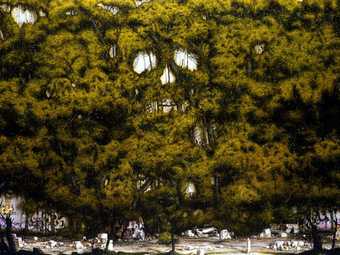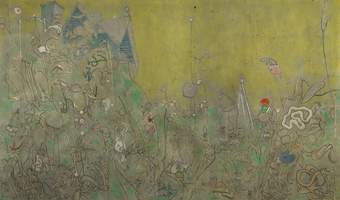Nigel Cooke’s paintings oscillate between extremes – he works on an epic scale but dwells on the minutiae of decay and dissolution, he paints with scientific accuracy but creates scenes that could never exist. Each canvas is composed with consummate skill but offers a less-than-reassuring encounter with entropy and excess. Thus, his paintings seem determined to short-circuit themselves, as if bent on self-destruction.
These grand canvases betray Cooke’s anxious preoccupation with the heroic ambitions of artists of the past, invoking a tradition of landscape painting which celebrated the sublime power of space. Cooke knows that such visions could inspire awe, and in both form and content his own works aspire to involve and overwhelm the viewer much as those vast historic landscapes of the nineteenth century did. But Cooke’s landscapes are dismal and dysfunctional, bile-coloured, littered with derelict buildings and burnt out cars, skulls and locusts. They are unlike any other landscape portrayed by an artist working today, and they cannot be described without resorting to hyperbole. Nature is depicted as a virulent force, sometimes morphing into skull-like shapes, spiralling out of control, forcing its way through cracks and crevices. Conversely, many of Cooke’s landscapes seem ‘anti-nature’, and the expanse of the picture plane is bare, suffused in ultraviolet hues. Their corners are scarred with menacing graffiti and the ground cluttered with Hallowe’en pumpkins, bones, severed heads and other paraphernalia derived from the classic and kitsch iconography of popular horror movies. The associations are universally unwholesome and sinister – decrepit, decaying and heavily clichéd – allowing Cooke to devise a kind of tragic-comic melodrama within each work.
Cooke’s images are meticulously painted, but this does not make their content any easier to absorb. As they crowd together in the Art Now room at Tate Britain, they inevitably produce a sense of anxiety and claustrophobia. Cooke’s intention is to unsettle us. His technical mastery is undeniable, but it seems that this skill is consistently put to mis-use. His choice of imagery, and his rendering of it, is self-consciously over-wrought. Thus our awe at his creation is undermined by a sense of bathos. The artist is more than aware of this, and the fact that a barren and ruined landscape is given such a seemingly incongruous title as Ghost on the Happy Trails substantiates this, adding an ironic twist of country-and-western music into the toxic cocktail.
Cooke prefers a shallow picture plane: there is little, if any, depth to the paintings. Each composition is usually anchored by a narrow horizontal base line. It is along this lower band that most of the detritus is gathered: the wrecked cars, the tree stumps, the cigarette butts, the rubble. In Ghost on the Happy Trails the larger expanse of the canvas describes a concrete wall (or it could be an overcast sky), its yellowish tones pierced by a rainbow-like arch of golden light (or equally a stream of urine). In contrast, a work such as Silva Morosa portrays nature creeping across and animating the whole surface of the canvas. A skull-like apparition is summoned from the few gaps left at the centre. In another gap, high in the left corner, a tiny face stares out, and on closer inspection other pairs of eyes can be found. Cooke’s little human heads are a disconcerting addition: they return the viewer’s gaze but communicate very little. From a distance, they easily become lost within the vast field of the painting, and since the canvas is hung so close to the floor they are more difficult to identify. The graffiti that is scrawled across the walls is yet another possible indication of human life, evidence of the humanisation and indeed personalisation of the terrain, but also a sign of protest and disorder. Of course, the graffiti is illegible, communicating no message to us, and so again our expectations are confused. The graffiti, like other aspects of the imagery Cooke uses, makes a link to the modern graphic novel or the popular comic book. Sitting at the intersection of literature and art, blending satire and caricature, the graphic novel perhaps finds a strange equivalence with some of Cooke’s imaginings.
It is no surprise that Cooke wears surgeon’s goggles to ensure the accuracy and clarity of his minute imagery. This means even microscopic details both bear up to and demand close scrutiny. Of course, this again undermines or contradicts the paintings’ grandeur and magnitude. So much information is compressed into even these details (or ‘wormholes’ as Cooke calls them) that it is impossible to take everything in at once. Cooke does not allow a painting to offer itself as an all-in-one entity, where its entire scale and the material handling of its details can be comprehended from a single viewpoint. He proposes that painting can and should be a multi-layered experience: the expressive power of tiny details pulls the spectator in, but then becomes magically invisible when we stand back from the canvas. Our visual experience is thus continually in flux, and we must keep moving to comprehend one order of magnitude over another. This can be frustrating.
So much is crammed into any one of Cooke’s canvases they are exhaustive and exhausting. In his mesmerising, phantasmagoric view of the world, the artist demonstrates the great chasms between realism and reality, between history and myth. Cooke endeavours to plot a course for painting that, in his own words, ‘shakes off the closure of its own historical death’, and by doing so he has given it an extremely perplexing after-life.
Text by Mary Horlock
Biography
Born Manchester, 1973
1999-2004 PHD in Fine Art, Goldsmiths College, London
1995-1997 MA Painting, Royal College of Art, London
1991-1994 BA (Hons) Fine Art, Nottingham Trent University
Lives and works in London


